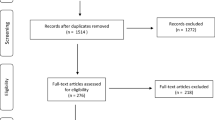Abstract
Alpha-theta neurofeedback has been shown to produce professionally significant performance improvements in music students. The present study aimed to extend this work to a different performing art and compare alpha-theta neurofeedback with another form of biofeedback: heart rate variability (HRV) biofeedback. Twenty-four ballroom and Latin dancers were randomly allocated to three groups, one receiving neurofeedback, one HRV biofeedback and one no intervention. Dance was assessed before and after training. Performance improvements were found in the biofeedback groups but not in the control group. Neurofeedback and HRV biofeedback benefited performance in different ways. A replication with larger sample sizes is required.
Similar content being viewed by others
References
Aftanas, L. I., & Golocheikine, S. A. (2001). Human anterior and frontal midline theta and lower alpha reflect emotionally positive state and internalised attention: High-resolution EEG investigation of meditation. Neuroscience Letters, 310, 57–60
Beauchaine, T. (2001). Vagal tone, development, and Gray’s motivational theory: Toward an integrated model of autonomic nervous system functioning in psychopathology. Developmental Psychopathology, 13(2), 183–214
Berger, B. C., & Gevirtz, R. (2001). The treatment of panic disorder. A comparison between breathing retraining and cognitive behaviour therapy. Applied Psychophysiology and Biofeedback, 26(3), 227–228
Bernardi, L., Sleight, P., Bandinelli, G., Cencetti, S., Fattorini, L., Wdowczyc-Szulc, J., & Lagi, A. (2001). Effect of rosary prayer and yogic mantras on autonomic cardiovascular rhythms: Comparative study. British Medical Journal, 323, 1446–1449
Bessel, J., & Gevirtz, R. (1998). Effects of breathing retraining versus cognitive techniques on cognitive and somatic components of state anxiety and on performance of female gymnasts. Biological Psychology, 48(1), 18
Budzynski, T. H. (1977). Tuning in on the Twilight Zone. Psychology Today, August
Del Pozo, J., & Gevirtz, R. (2002). The effect of resonant frequency cardiac biofeedback training on heart rate variability in a cardiac rehabilitation population. Applied Psychophysiology and Biofeedback, 27(4), 311
Doppelmayr, M., Klimesch, W., Pachinger, T., & Ripper, B. (1998). Individual differences in brain dynamics: Important implications for the calculation of event-related band power. Biological Cybernetics, 79, (1) 49–57
Doussard-Roosevelt, J. A., Porges, S. W., Scanlon, J. W., Alemi, B., & Scanlon, K. B. (1997). Vagal regulation of heart rate in the prediction of developmental outcome for very low birth weight preterm infants. Child Development, 68(2), 173–186
Egner, T., & Gruzelier, J. H. (2001). Learned self-regulation of EEG frequency components affects attention and event-related brain potentials in humans. Neuroreport, 12(18), 4155–4159
Egner, T., & Gruzelier, J. H. (2003). Ecological validity of neurofeedback: Modulation of slow-wave EEG enhances musical performance. Neuroreport, 14(9), 1221–1224
Egner, T., & Gruzelier, J. H. (2004a). The temporal dynamics of electroencephalographic responses to alpha/theta neurofeedback training in healthy subjects. Journal of Neurotherapy, 8(1), 43–58
Egner, T., & Gruzelier, J. H. (2004b). EEG biofeedback of low beta band components: Frequency-specific effects on variables of attention and event-related brain potentials. Clinical Neurophysiology, 115, 131–139
Fazey, J., & Hardy, L. (1988). The inverted-U hypothesis – a catastrophe for sport psychology. British Association of Sports Sciences Monograph, 1, Leeds, UK: National Coaching Foundation
Fuchs, T., Birbaumer, N., Lutzenberger, W., Gruzelier, J. H., & Kaiser, J. (2003). Neurofeedback treatment for attention-deficit/hyperactivity disorder in children: A comparison with methylphenidate. Applied Psychophysiology and Biofeedback, 28(1), 1–12
Gruzelier, J. H., & Egner, T. (2004) Physiological self-regulation: Biofeedback and neurofeedback. In A. Williamon (Ed.), Musical excellence; strategies and techniques to enhance performance (pp. 197–219). Oxford: Oxford University Press
Kamiya, J. (1968). Conscious control of brainwaves. Psychology Today, 1, 56–60
Lehrer, P. M., Vaschillo, E., & Vaschillo, B. (2000). Resonant frequency biofeedback training to increase cardiac variability: Rationale and manual for training. Applied Psychophysiology and Biofeedback, 25(3), 177–191
Mezzacappa, E., Tremblay, R. E., Kindlon, D., Saul, J. P., Arseneault, L., Seguin, J., Pihl, R. O., & Earls, F. (1997). Anxiety, antisocial behavior and heart rate regulation in adolescent males. Journal of Child Psychology and Psychiatry and Allied Disciplines, 38(4), 457–469
Peniston, E. G., & Kulkosky, P. J. (1990). Alcoholic personality and alpha-theta brainwave training. Medical Psychotherapy, 3, 37–55
Porges, S. W. (2003) The Polyvagal Theory: Phylogenetic contributions to social behavior. Physiology and Behaviour, 79(3), 503–513
Raymond, J., Varney, C., Parkinson, L. A., & Gruzelier, J. H. (2005). The effects of alpha/theta neurofeedback on personality and mood. Cognitive Brain Research (in press)
Rossiter, T. R., & LaVaque, T. J. (1995). A comparison of EEG biofeedback and psychostimulants in treating attention deficit hyperactivity disorders. Journal of Neurotherapy, 1, 48–59
Sloan, R. P., Shapiro, P. A., Bigger, J. T., Bagiella, E., Steinman, R. C., & Gorman, J. M. (1994). Cardiac autonomic control and hostility in healthy subjects. American Journal of Cardiology, 74(3), 298–300
Vernon, D., Frick, A., & Gruzelier, J. H. (2004). Neurofeedback as a treatment for ADHD: A methodological review with implications for future research. Journal of Neurotherapy, 8, 53–82
Vernon, D., Egner, T., Cooper, N., Compton, T., Neilands, C., Sheri, A., & Gruzelier, J. H. (2003). The effect of training distinct neurofeedback protocols on aspects of cognitive performance. International Journal of Psychophysiology, 47, 75–85
Weinberg, R. S., Seabourne, T. G., & Jackson, A. (1981). Effects of visuo-motor behavior rehearsal, relaxation, and imagery on karate performance. Journal of Sport Psychology, 3, 228–238
Wrisberg, C. A., & Anshel, M. H. (1989). The effect of cognitive strategies on the free throw shooting performance of young athletes. The Sport Psychologist, 3, 95–104
Yeragani, V. K., Pohl, R., Balon, R., Ramesh, C., Glitz, D., Jung, I., & Sherwood, P. (1991). Heart rate variability in patients with major depression. Psychiatry Research, 37I(1), 35–46
Yeragani, V. K., Pohl, R., Berger, R., Balon, R., Ramesh, C., Glitz, D., Srinivasan, K., & Weinberg, P. (1993). Psychiatry Research, 46(1), 89–103
Yerkes, R. M., & Dodson, J. D. (1908). The relation of strength of stimulus to the rapidity of habit formation. Journal of Comparative Neurology and Psychology, 18, 459–482
Author information
Authors and Affiliations
Corresponding author
Rights and permissions
About this article
Cite this article
Raymond, J., Sajid, I., Parkinson, L.A. et al. Biofeedback and Dance Performance: A Preliminary Investigation. Appl Psychophysiol Biofeedback 30, 65–73 (2005). https://doi.org/10.1007/s10484-005-2175-x
Issue Date:
DOI: https://doi.org/10.1007/s10484-005-2175-x




